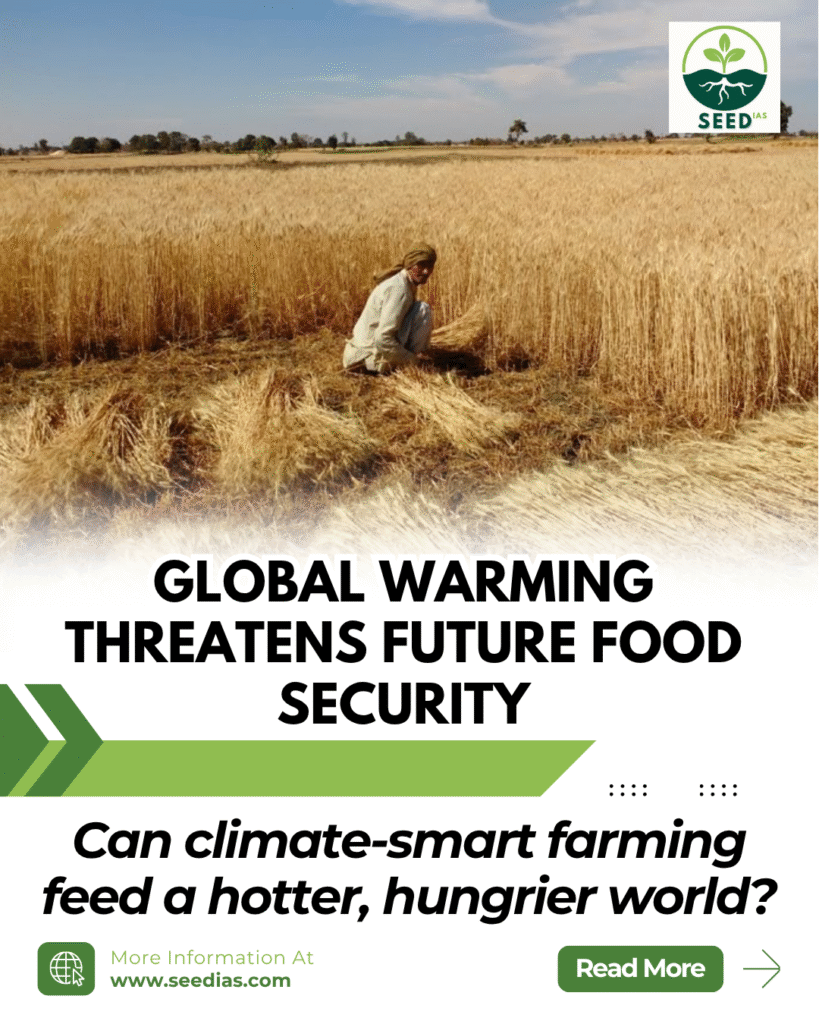Why in NEWS
A new study warns that a 1°C rise in global temperature could slash per capita calorie availability by 4% by 2100, severely impacting global food security, especially through declines in staple crops like wheat, rice, maize, and soybean.
Key Concepts Simplified
| Term | Meaning |
|---|---|
| Per Capita Calorie Availability | Average amount of calories available per person; indicator of food security |
| Farmer Adaptation | Adjustments in farming practices such as crop choice, sowing dates, and irrigation in response to climate |
| Heat-Resistant Varieties | Crop strains developed to tolerate high temperatures and extreme weather conditions |
News Details
- Global warming threatens to reduce food availability even with farmer adaptation.
- Farmers using heat-tolerant crops and revised practices may reduce crop losses by 23% (by 2050) and 34% (by 2100), but major losses remain unavoidable—especially for wheat, maize, and soybean.
- Wheat yields may fall by 30–40% in China, Russia, US, and Canada. Northern India is among the worst-hit regions.
- Rice yields may remain stable in India and Southeast Asia, but fall by 50% or more in Sub-Saharan Africa and Europe.
- Global food security will be affected across both developing and developed nations, stressing the urgency of climate-resilient agriculture.
Key Findings from the Study
| Aspect | Details |
|---|---|
| Calorie Impact | Every 1°C rise in temperature may lead to a 4% reduction in per capita calorie availability by 2100. |
| Farmer Adaptation Impact | Adaptation (e.g., heat-resistant varieties, adjusted sowing/watering) could reduce losses by 23% (2050) and 34% (2100). |
| Wheat Yield Decline (2050–2100) | May drop by 30–40% in China, Russia, US, Canada, with northern India worst affected. |
| Rice Yield Trends | Mixed impact in India and Southeast Asia, but over 50% decline in Sub-Saharan Africa and Europe. |
| Maize and Soybean Trends | Expected to face significant global declines. |
| Regions Affected | Losses will affect both developing countries and modern breadbaskets like the US, Europe, and China. |
| Suggested Solutions | Innovation, cropland expansion, and climate-resilient agriculture practices needed urgently. |
In a Nutshell
Memory Code: “CRASH-WORM”
- Calorie decline
- Rice mixed
- Adaptation partial
- Soybean shrinking
- Heat-resistant crops
- Wheat falls
- Overall impact
- Resilient practices
- Maize loss
Prelims Practice Questions
- Which crop is expected to show the least impact from rising temperatures in India and Southeast Asia?
A. Wheat
B. Maize
C. Rice
D. Soybean - What is the projected drop in global per capita calorie availability by 2100 due to 1°C rise in temperature?
A. 10%
B. 6%
C. 4%
D. 2% - Which region is likely to be among the worst-hit for wheat yields by 2100?
A. Western Europe
B. Sub-Saharan Africa
C. Northern India
D. Central Asia
Mains Questions
- Discuss the impact of global warming on food security, with reference to the recent study on crop yield decline. (GS3 – Climate Change, Agriculture)
- Examine the role of adaptive farming practices in building climate resilience for staple crops. (GS3 – Food Security, Technology in Agriculture)
Prelims Answer Key with Explanations
| Qn | Answer | Explanation |
|---|---|---|
| 1 | C | Rice shows relatively stable yield in India and Southeast Asia compared to other crops. |
| 2 | C | The study notes a 4% drop in calorie availability per person by 2100 for every 1°C rise. |
| 3 | C | Northern India is identified as one of the worst-affected regions for wheat yield decline. |
















